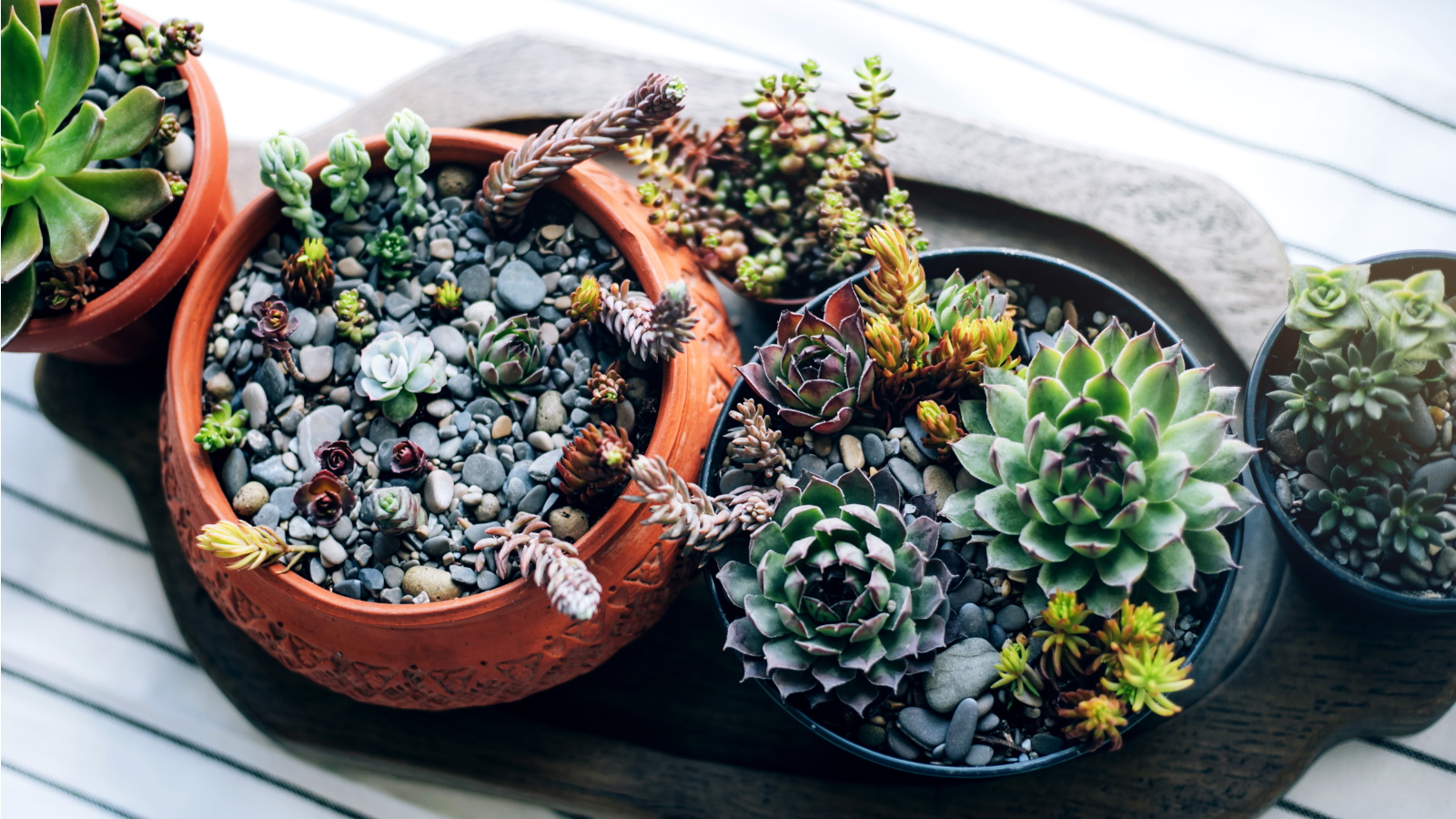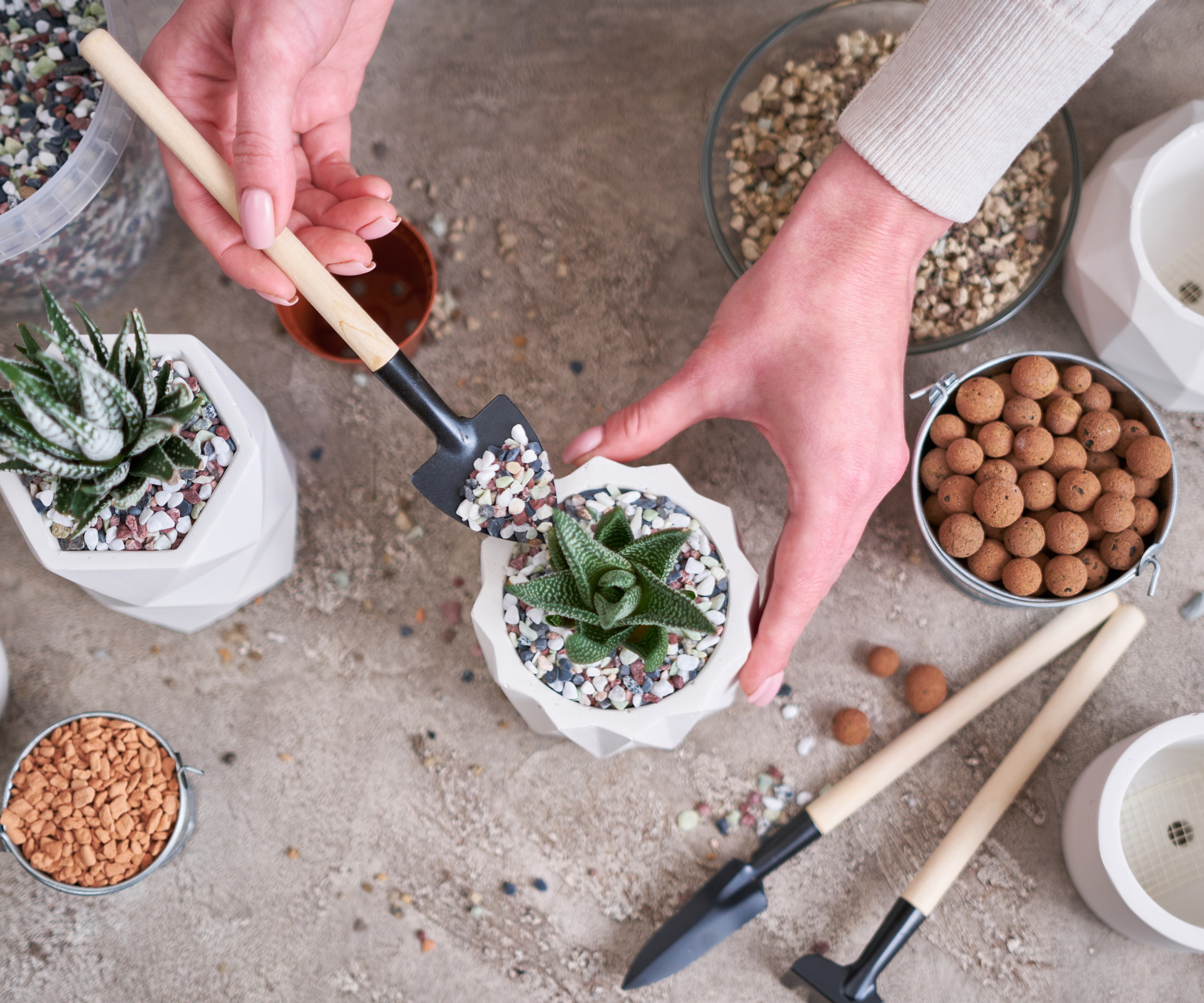How to make your own succulent potting mix – a quick DIY fix that will keep these tropical plants growing for years
Succulents need a loose structure to grow in with plenty of drainage


Succulents have been popular houseplants for a long time, loved for their low-maintenance nature and their unique and wonderful shapes. They're also incredibly versatile and can be used in so many ways in the home, thriving without much attention. Something you do have to get right to keep them happy, however, is their potting mix.
Caring for succulents is easy, but they do require sufficient drainage to replicate their natural growing environment. I have over 10 different types of succulents in my houseplant collection and have experimented with styling them in different ways. When creating my own succulent centrepiece for a coffee table, I used the best potting soil for houseplants and amended it with materials that would improve aeration. Ever since, the succulents in my arrangement have happily doubled in size.
It's really straightforward to make a DIY potting mix like this, so your succulents continue growing for years and years. Here, I've put together the ultimate guide to making your own succulent potting mix.
Succulent potting mix recipe

There are so many combinations of soil mixtures to use for succulents you can create, but the below recipe is a quick and simple one that will give your succulents everything they need.
You will need:
- Pebbles or gravel
- Fertile, well-draining potting soil
- Coarse sand
- Perlite and/or vermiculite
- Horticultural charcoal powder
Start by placing a layer of pebbles or gravel at the bottom of your plant pot. I use pea gravel, like this from Amazon. By placing it at the bottom, you add drainage and allow excess moisture to flow out of the potting mix. 'This will also prevent the substrate from washing out through the drainage holes,' says Anastasia Borisevich of Plantum. You can likewise use the coffee filter at the bottom of a plant pot hack for this.
You should then put your main potting mix together. The proportions should be equal parts potting soil and coarse sand (from Walmart). This potting soil from Amazon is fertile and well-draining, so is a good choice. This mixture creates a reliable base for growing your succulents.
Design expertise in your inbox – from inspiring decorating ideas and beautiful celebrity homes to practical gardening advice and shopping round-ups.
Next, you can add amendments to further aid aeration and water absorption - perlite, vermiculite and horticultural charcoal powder, available at Amazon. Your amendments should total half the amount of potting soil used.
It's as simple as that. 'Mix everything thoroughly, fill the containers with the substrate, and pot the plants,' says Anastasia.
As an optional bonus, and one that I like to add to my succulent pots, you can put a layer of pebbles on top of you potting mix once your succulents are potted. This is a popular solution for tropical indoor plants, as it helps increase humidity for indoor plants.
Why these are the best ingredients for succulent potting mix

There are so many things you can add to houseplant soil - from coffee grounds for plants to using rice water on orchids. When it comes to curating the perfect succulent potting mix, the options are endless.
While you can use a potting soil for succulents, coco coir is also an option. It provides a loose structure and retains moisture well, aiding the needs of succulents.
One of the biggest succulent mistakes is not watering succulents correctly. These plants are drought-tolerant and don't need as frequent watering as some houseplants. Including materials that add drainage is therefore essential in a succulent potting mix, preventing the plants sitting in too-wet soil which can lead to problems such as houseplant root rot.
'One preparatory step before repotting your succulent is placing a layer of drainage material - gravel, expanded clay pebbles, or brick chips,' says Anastasia. 'This will facilitate the outflow of excess moisture after watering,' she says.
It's also key to not have a compacted potting mix, Anastasia notes, as it can trap excess moisture. That's why commercial succulent potting mix, like this one from Amazon, is a loose formula. 'They tend to be nutritious, airy, and well-draining,' Anastasia says.
Perlite, sand and vermiculite are all found in different succulent mixes for this reason. They add air pockets in the potting soil, make it finer while also absorbing excess moisture.
Horticultural charcoal powder is used in potting mix for a number of reasons. Firstly, it's porous and absorbs excess moisture, but it also repels common houseplant pests and prevent mold and mildew - something succulents are prone to when overwatered.
As for providing your succulents with nutrients, these low-maintenance indoor plants aren't as reliant on fertilizer as other plants. For this reason, the above ingredients should suffice in supporting the growth of your succulents, so long as you use a fertile and nutritious potting soil base. Nevertheless, your succulents can benefit from an occasional boost of fertilizer during its active growth season.

Anastasia Borisevich is a resident plant expert for the Plantum app, which helps users identify plant species, diagnose their conditions, and get specific care advice. She has three years of experience consulting on botany-related topics for Plantum (formerly NatureID).
FAQs
What's the best type of pot for succulents?
Succulents do best in a pot that aids drainage. This includes pots with drainage holes and saucers to catch excess water, as well as indoor terracotta planters which are porous. If you are using succulents in a DIY, such as a succulent bowl or centrepiece, it's a good idea to drill drainage holes into the bottom of the vessel you use.
Of course, there are so many different kinds of succulents you can grow at home. However, this mixture will work well for most types of succulents. If you have made a DIY potting mix and notice your succulents turning yellow, it could be a sign your mix is holding onto too much moisture and needs to be amended to make it finer.

Tenielle is a Gardens Content Editor at Homes & Gardens. She holds a qualification in MA Magazine Journalism and has over six years of journalistic experience. Before coming to Homes & Gardens, Tenielle was in the editorial department at the Royal Horticultural Society and worked on The Garden magazine. As our in-house houseplant expert, Tenielle writes on a range of solutions to houseplant problems, as well as other 'how to' guides, inspiring garden projects, and the latest gardening news. When she isn't writing, Tenielle can be found propagating her ever-growing collection of indoor plants, helping others overcome common houseplant pests and diseases, volunteering at a local gardening club, and attending gardening workshops, like a composting masterclass.